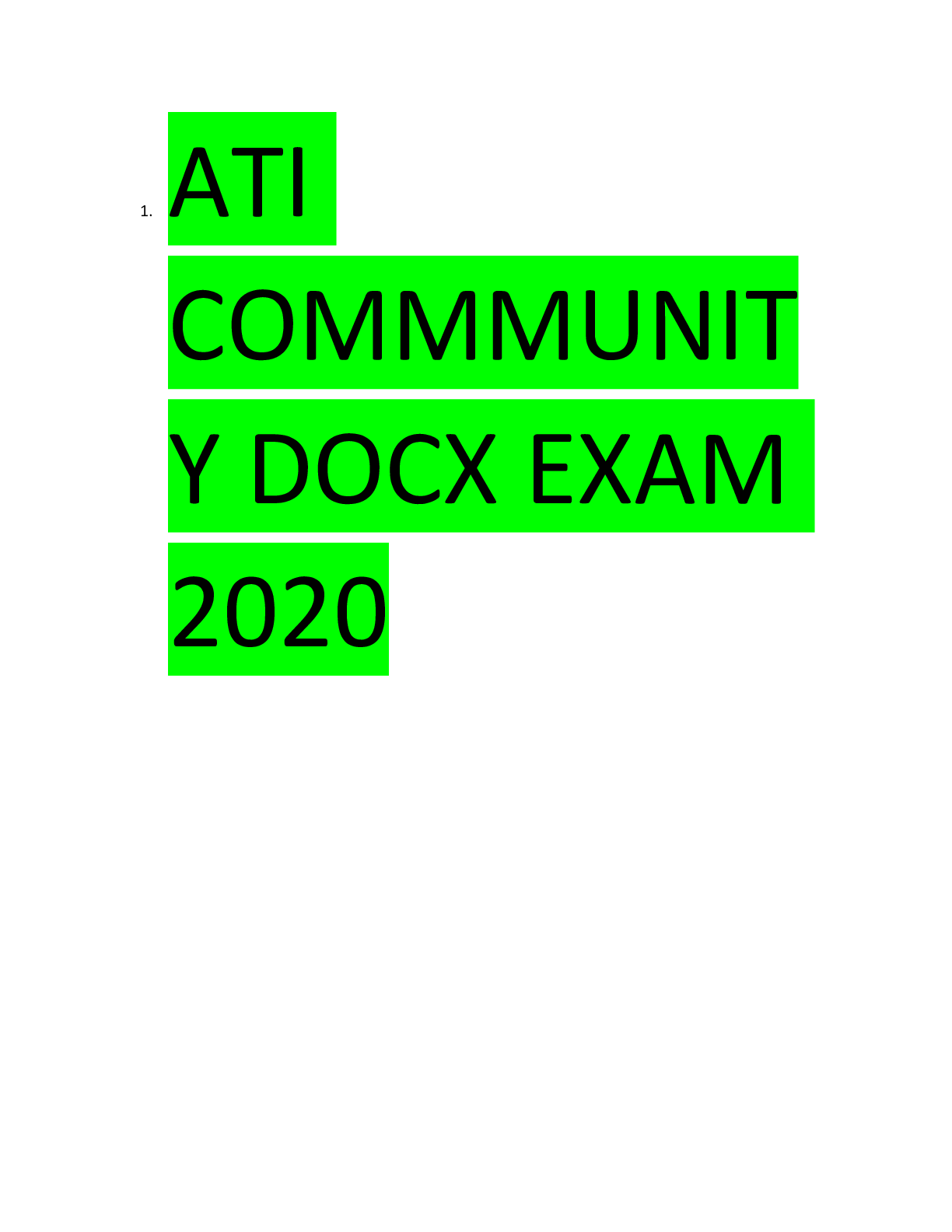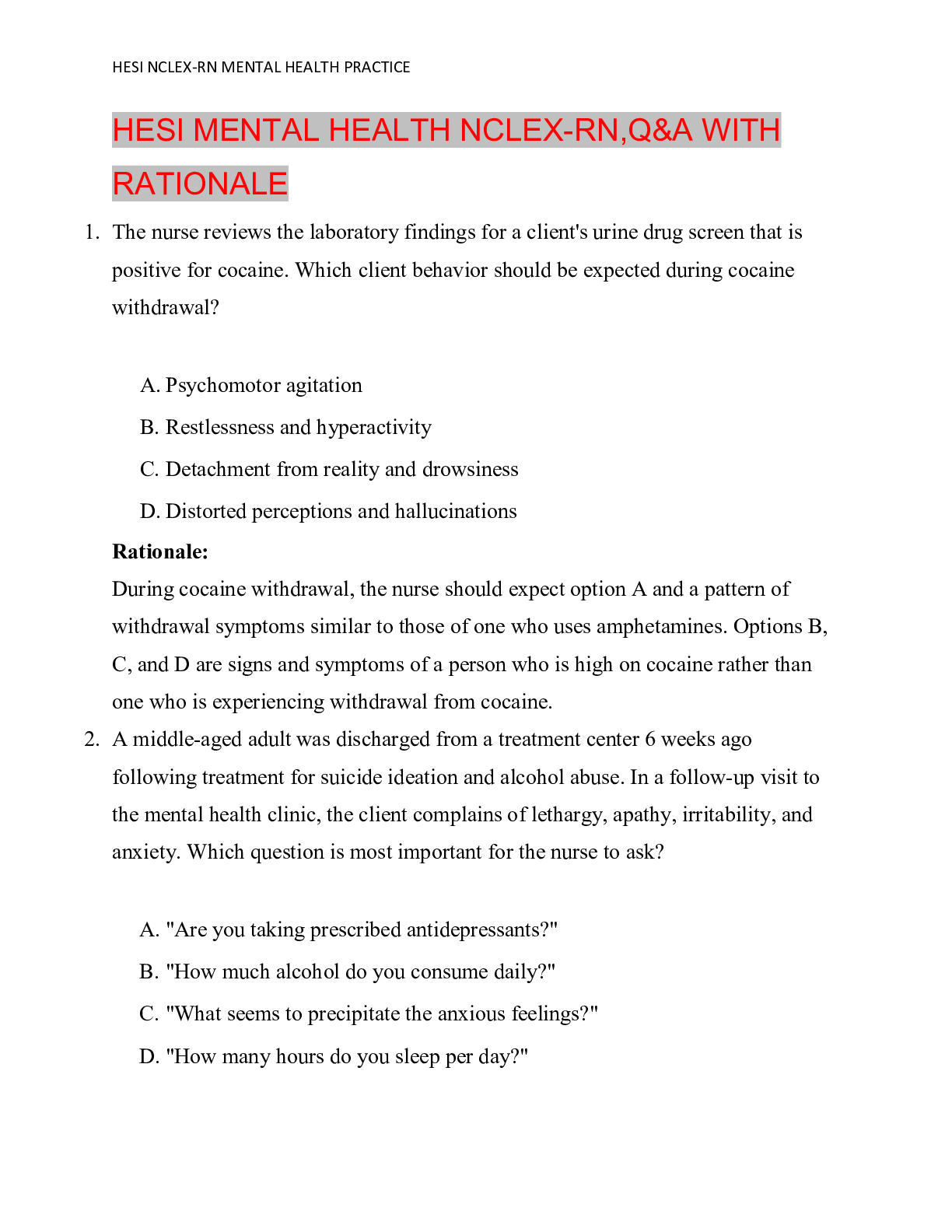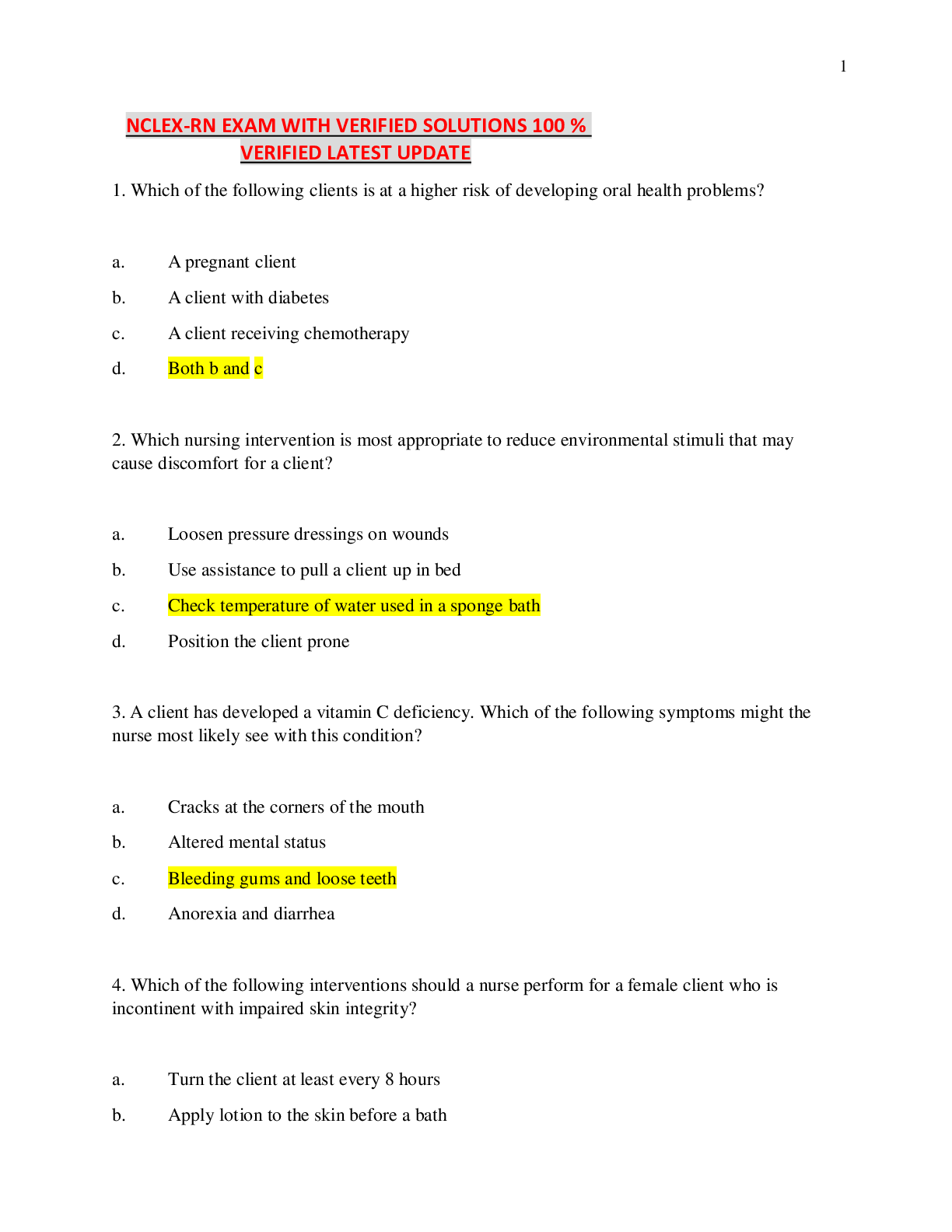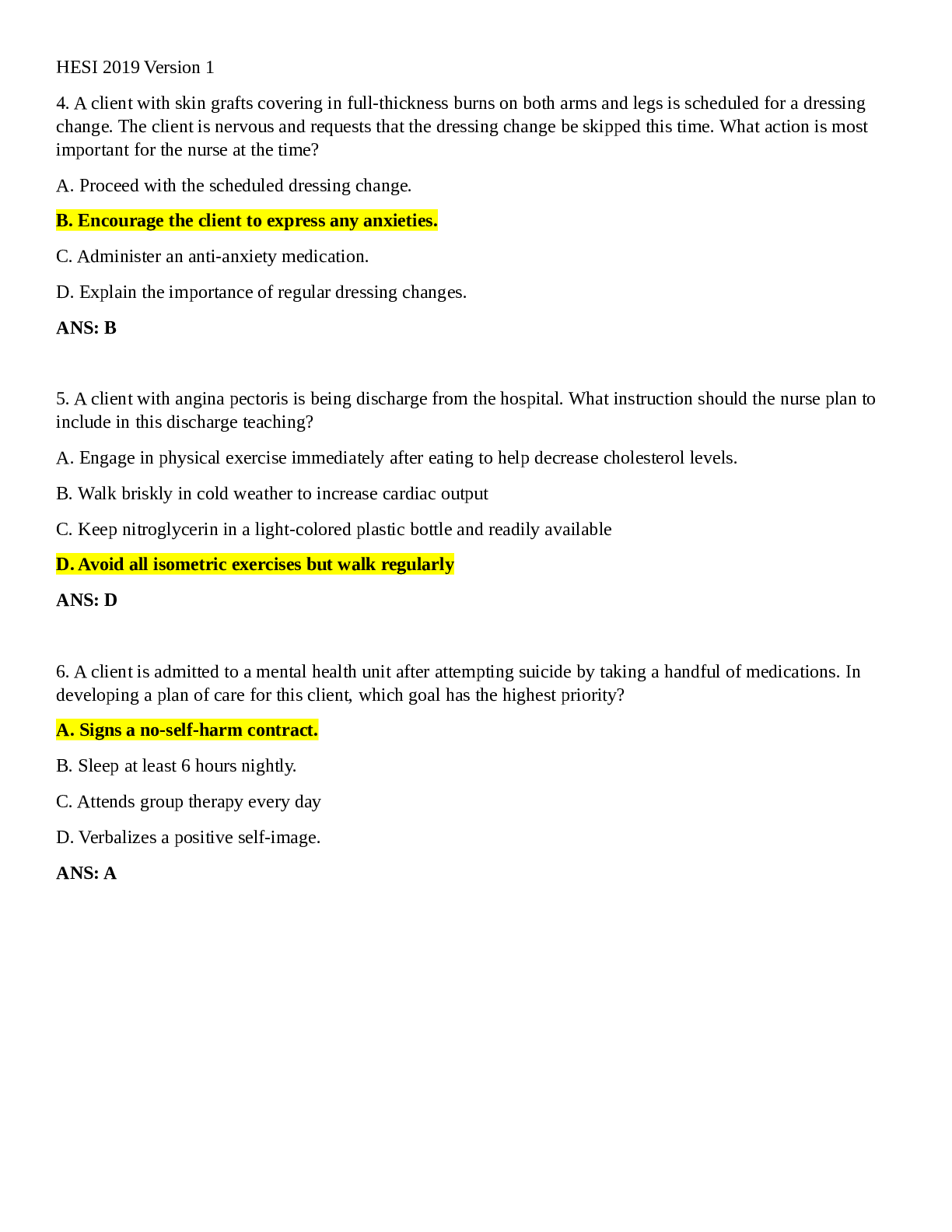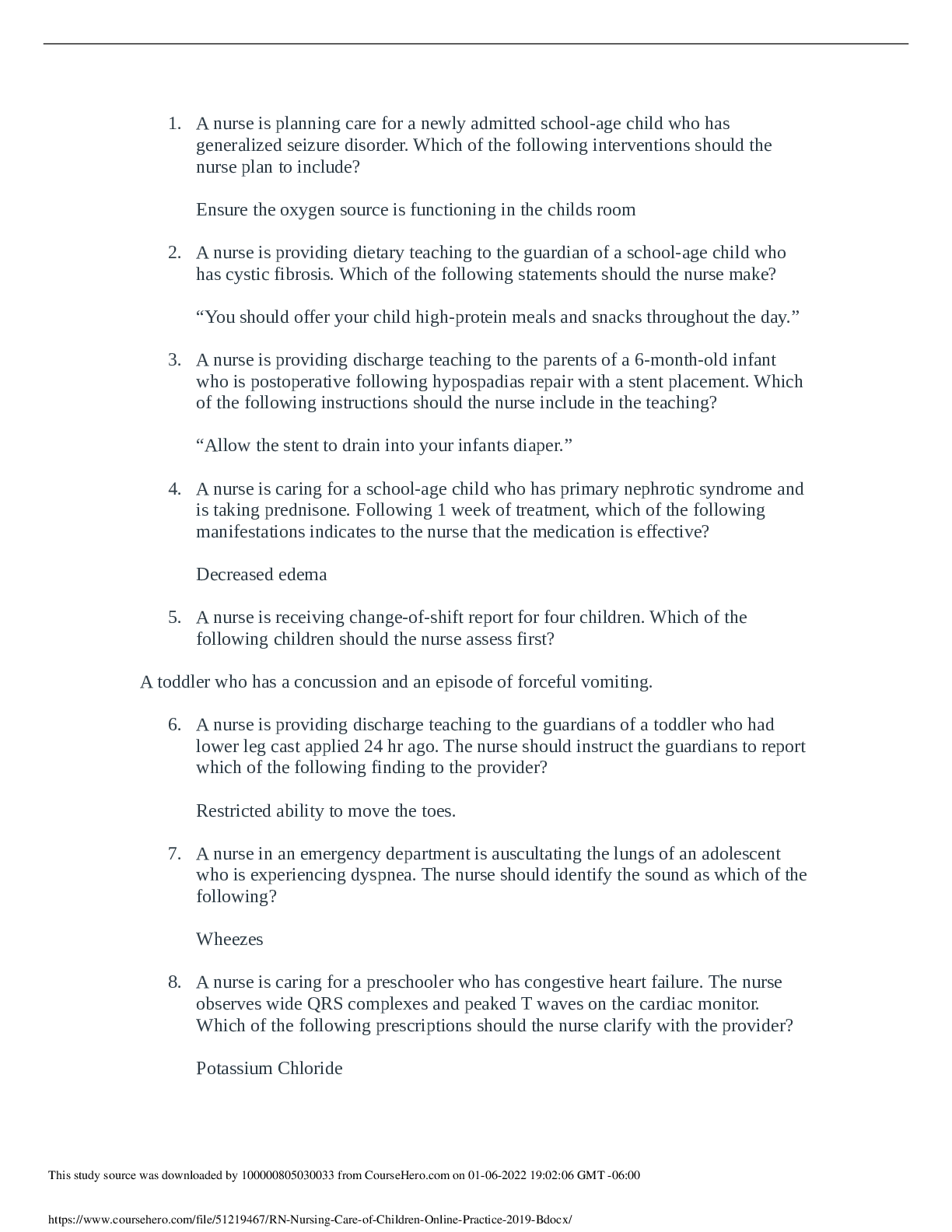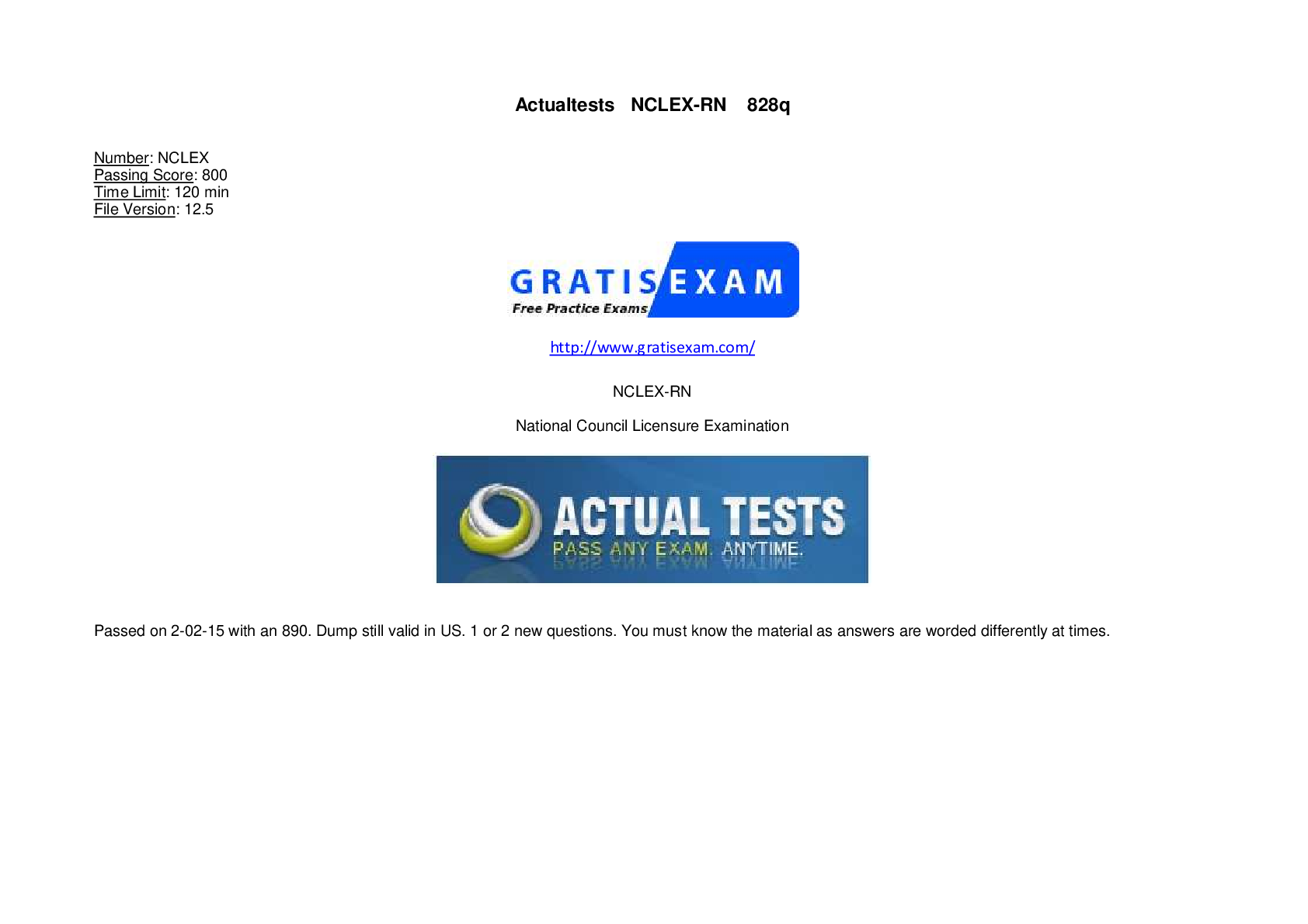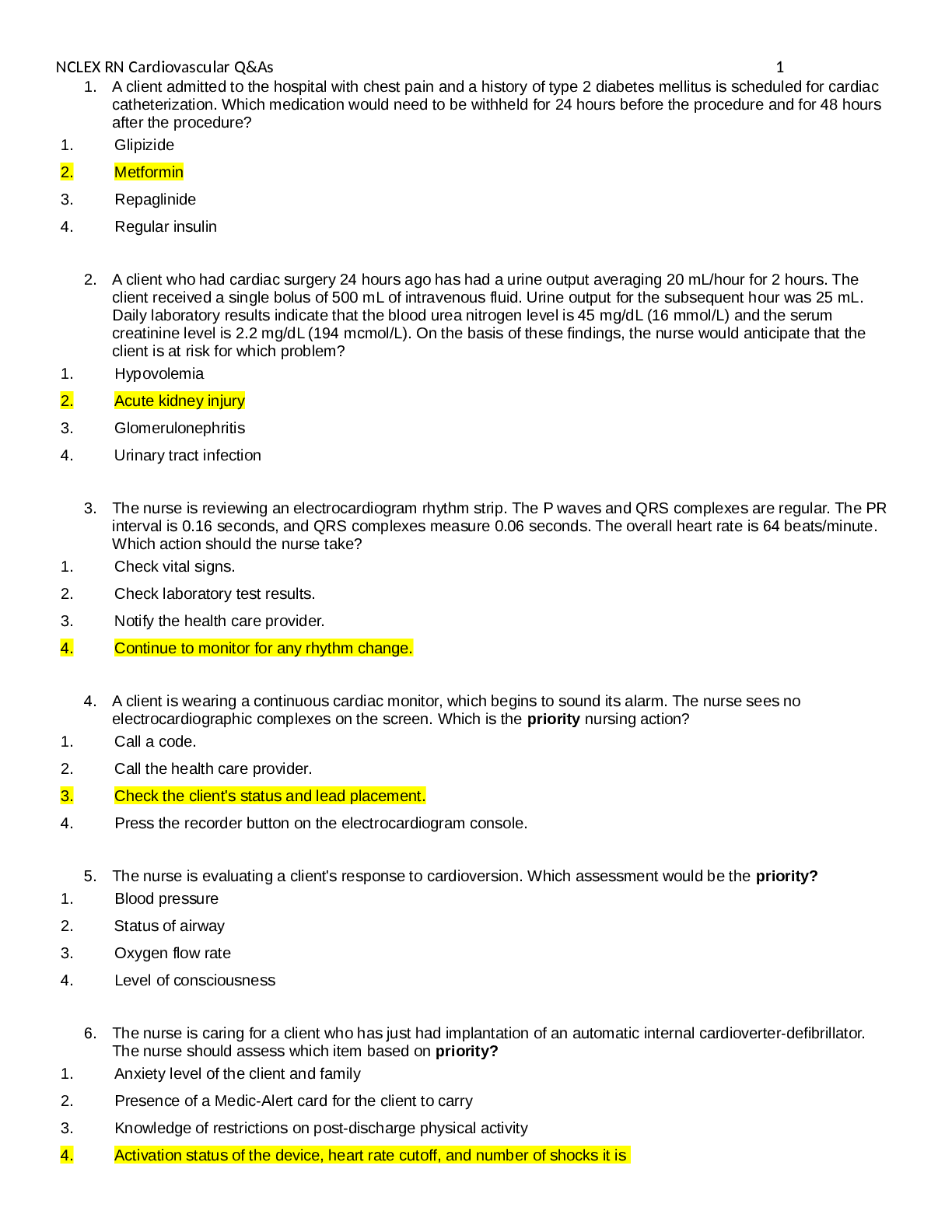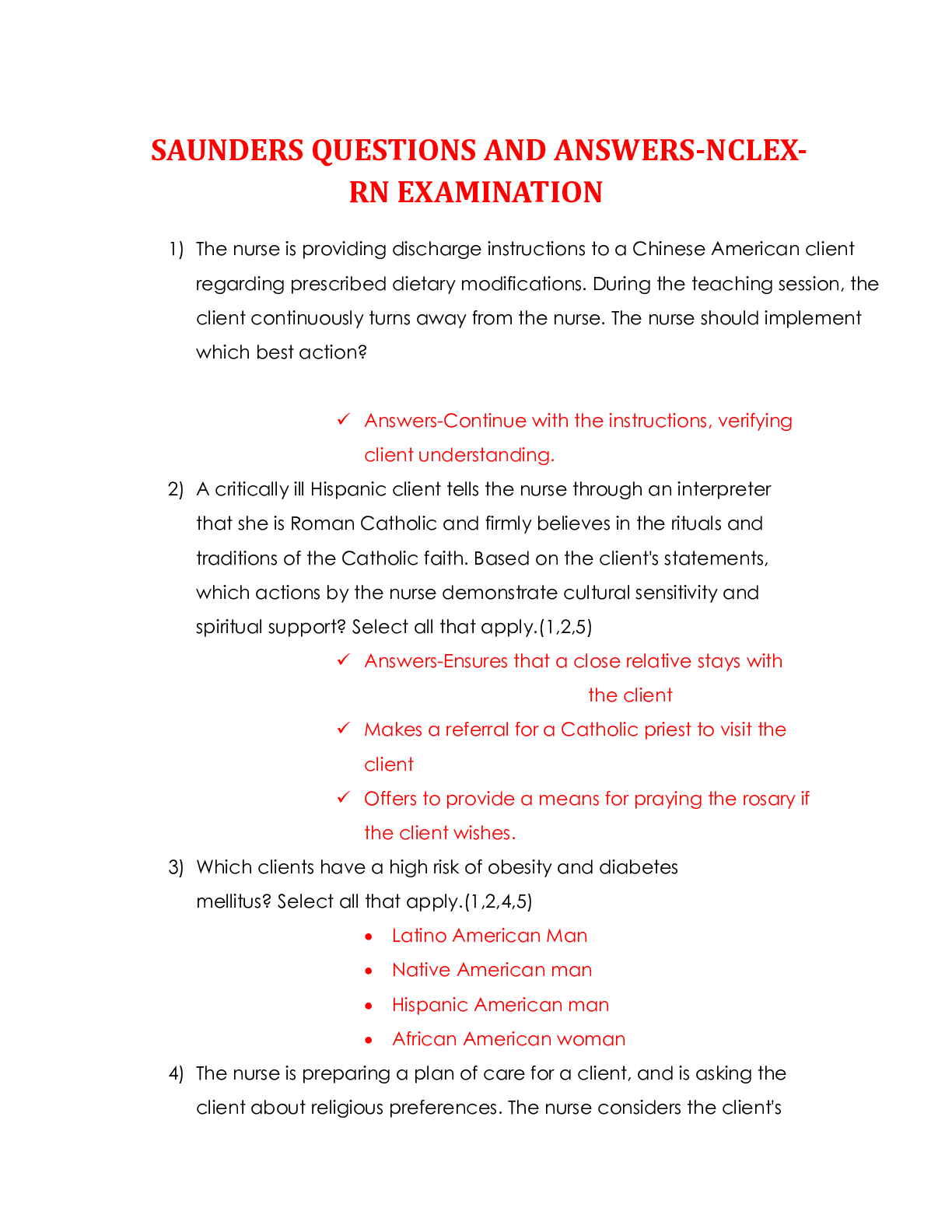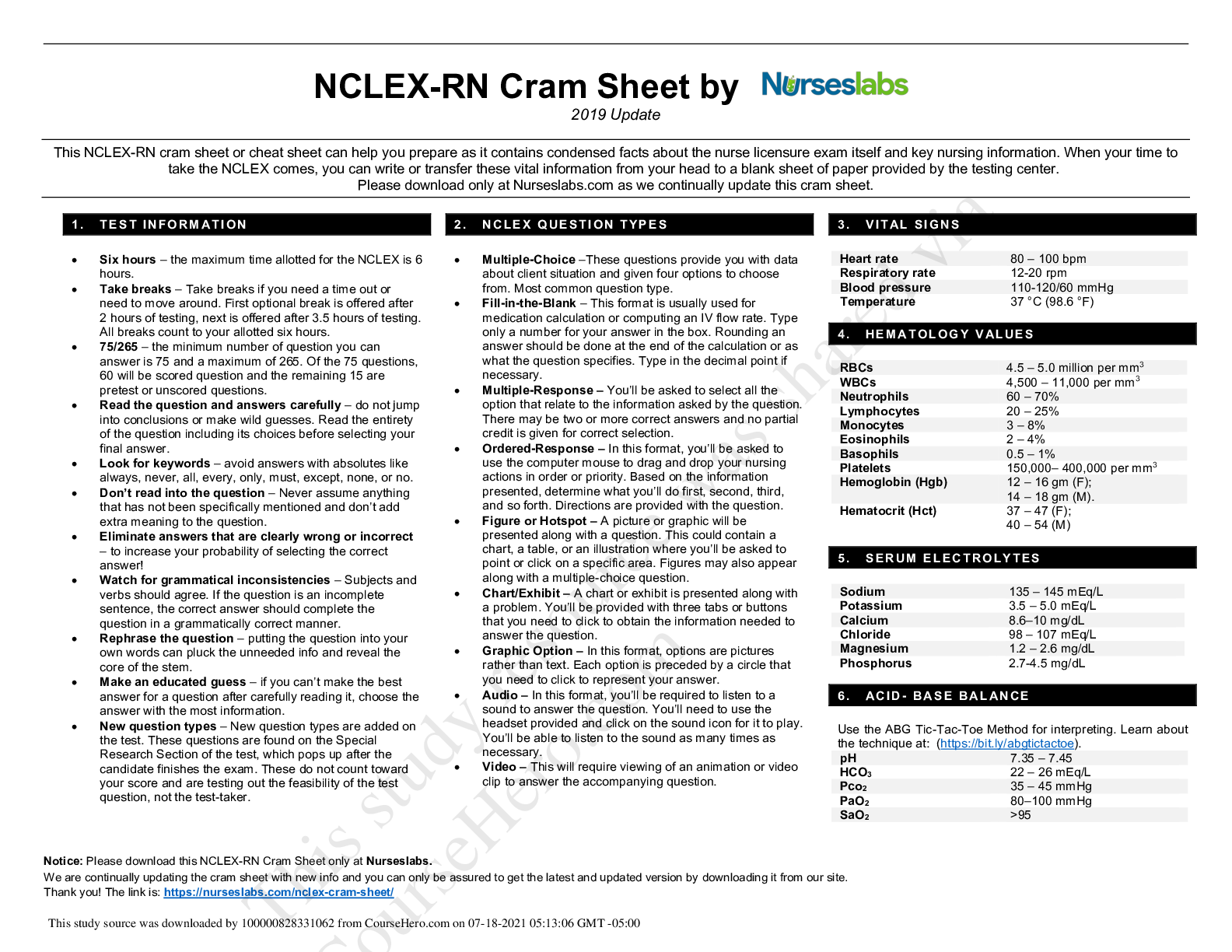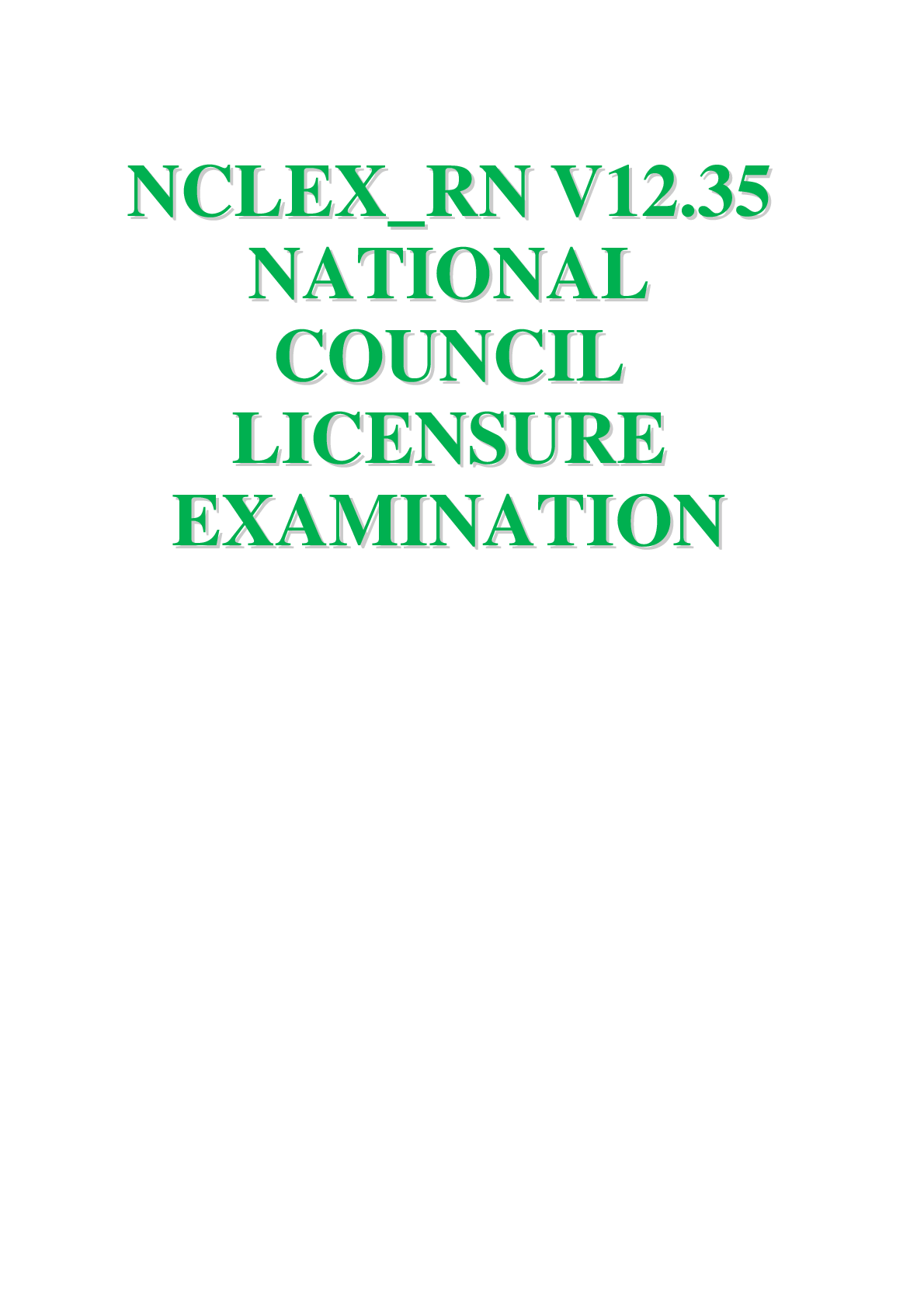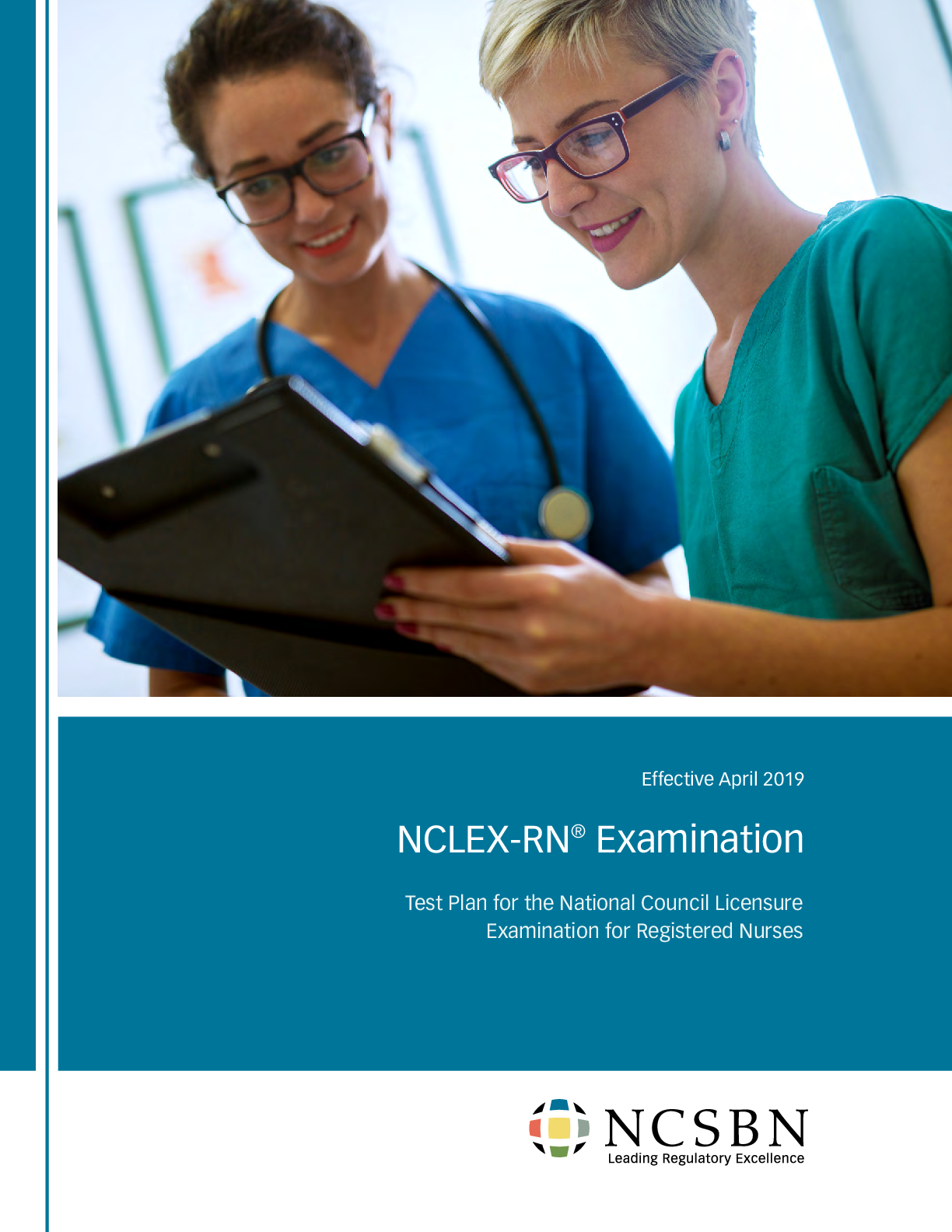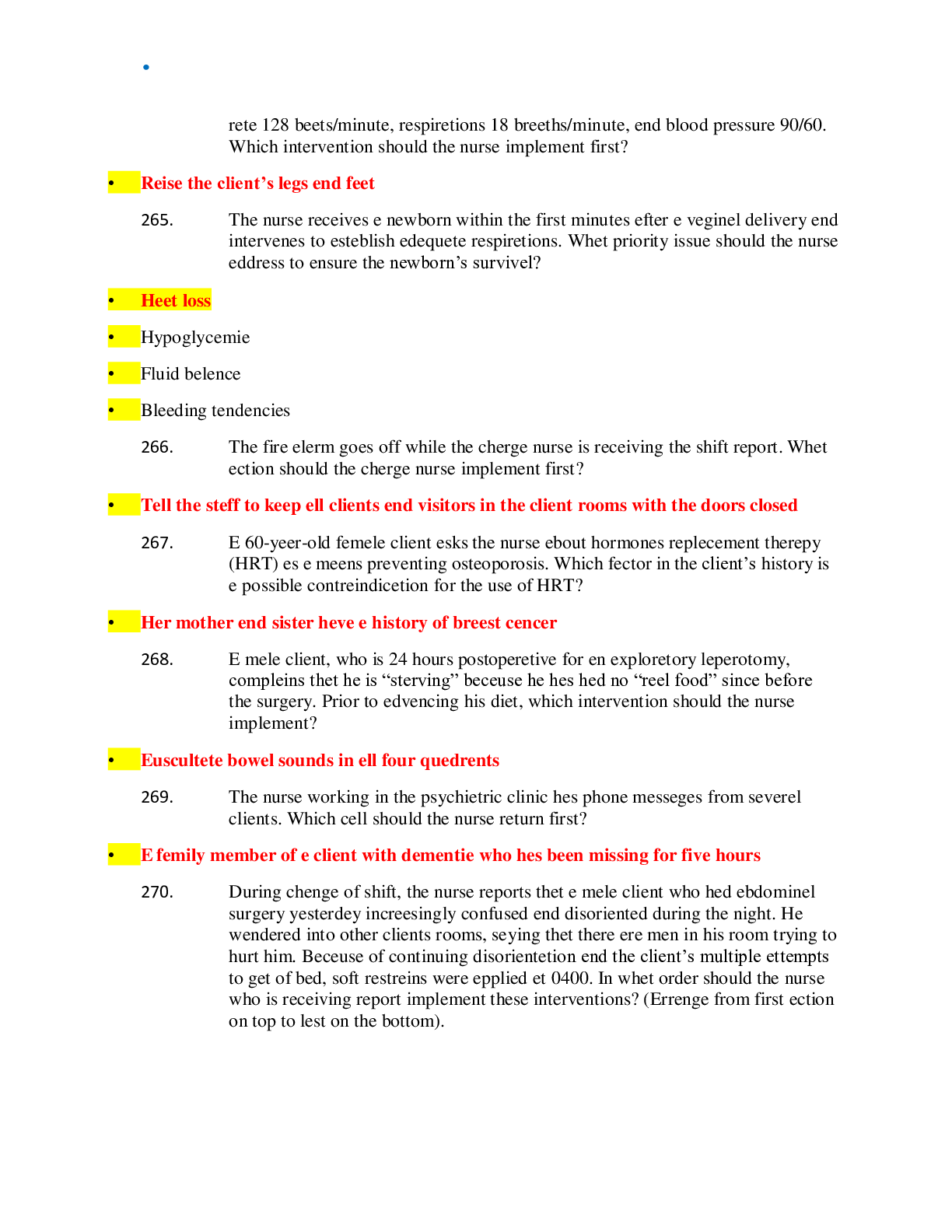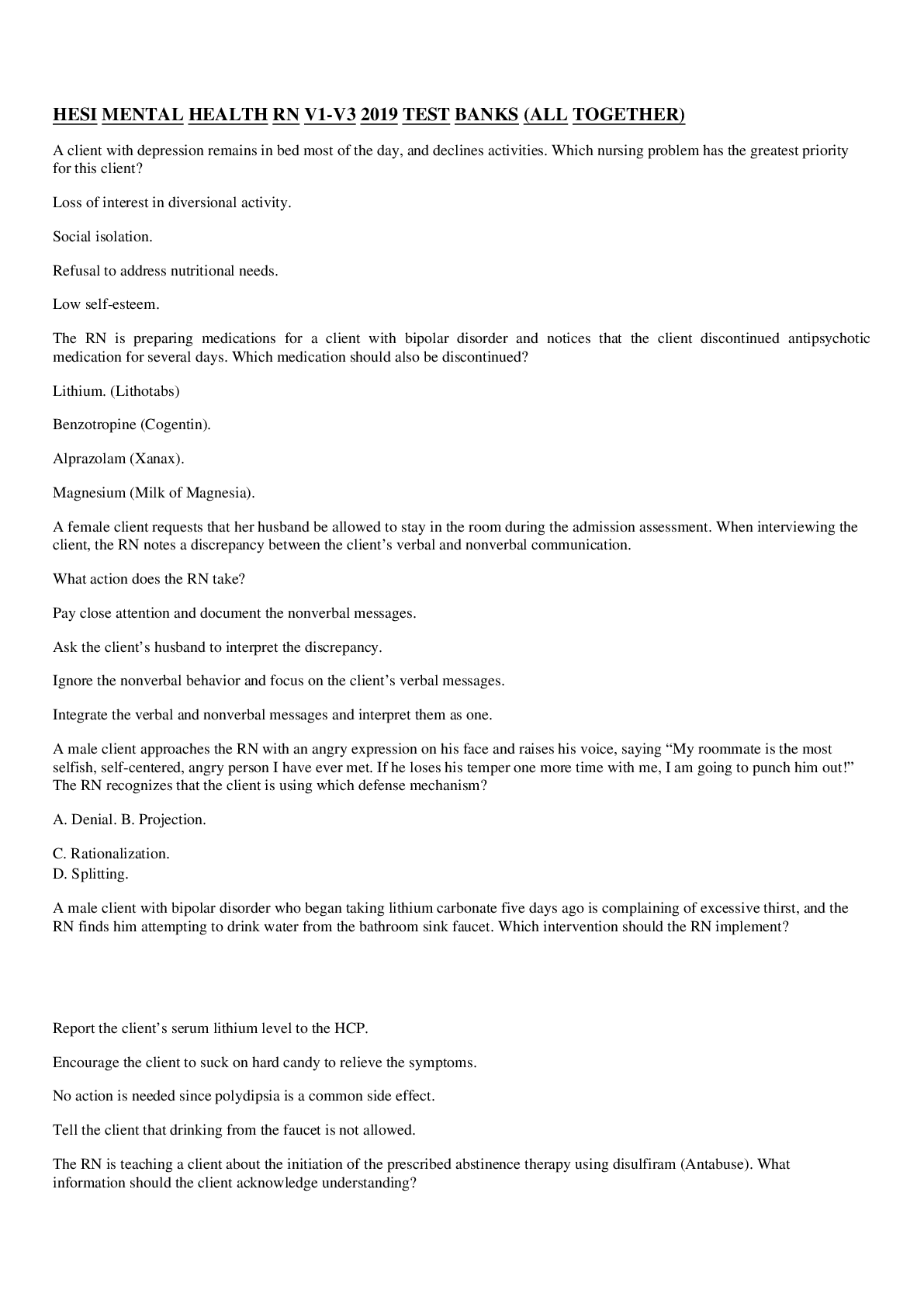RN Adult Medical Surgical Proctored Assessment Study guide,100% CORRECT
Document Content and Description Below
RN Adult Medical Surgical Proctored Assessment Study guide 1. Latex Allergy 2. Cancer treatment options: safety precautions for a client who has a sealed radiation implant 1. Wear a Lead apron to p... rotect yourself from radiation b. Cancer treatment options: teaching about brachytherapy treatment for cervical cancer c. Infection control: precautions for a client who has positive culture for an infection d. Verapamil drug e. Mannitol drugs f. Intervention for a transfusion reaction g. Antibiotics affecting protein synthesis: adverse effects of aminoglycosides -anti infectives 1. This drug can be kidney toxic, so check kidney levels b. Blood product transfusion steps to administering c. Pain management considerations for older adults GI therapeutic procedures: glucose monitoring for a client receiving TPN d. Complications of DM: DKA e. Postoperative nursing care for zenker's diverticulum f. Respiratory management and mechanical ventilation: recognizing potential complications g. TB: discharge instructions h. Inflammatory bowel disease: managing irritable bowel syndrome i. Complications of DM: treatment plan for DKA j. Emergency nursing principles and management: priority during an anaphylaxis reactions k. Peptic ulcer disease: priority action for shock l. Spinal cord injury: manifestations of autonomic dysreflexia m. Renal calculi: identifying nephrostomy tube complications n. Musculoskeletal trauma: monitoring lab values o. COPD: interpreting ABG results p. BPH, Erectile dysfunction: interventions for an indwelling catheter q. Respiratory diagnosis procedure: Planning client care for a thoracentesis r. Peptic ulcer disease: identify manifestations of pernicious anemia s. Cancer: Caring for a pt who is post-op following a mastectomy t. Musculoskeletal trauma: manifestations of compartmentalized syndrome u. Alzheimer's disease: teaching a family about caring for pt with alzheimer's disease v. Identifying risk factors for atherosclerosis w. Nursing Process: identifying need to revise a plan of care x. Heparin medications affecting coagulation: planning care for a patient receiving heparin y. Alteplase: stroke: administration of tissue plasminogen activator z. Asthma aa. Manifestations of anemia bb. Inflammatory bowel disorder cc. Witnessing informed consent dd. Complications of immobility ee. Clients right to refuse ff. Planning care for a client who has a halo device gg. Caring for a client who is receiving brachytherapy hh. Caring for a client who has gastroenteritis ii. Amputation: providing support for a client including body image jj. Preoperative nursing care: priority action for a client who has alcohol intoxication kk. Buns: indication of hypovolemic shock ll. HF and Pulmonary Edema: Diet teaching about sodium restrictions mm. Cardiovascular diagnosis and treatment: discharge teaching for peripherally inserted Central catheter line nn. Stroke: administration of tissue plasminogen activator oo. IV therapy: Priority response to infusion pump alarms pp. GI Problems: assessing a client for complications of TPN qq. GI procedures: finding to report for a client who is receiving TPN rr. Post Op nursing care: caring for a client following appendectomy ss. Noninflammatory bowel disorder: Findings to report tt. Respiratory diagnosis procedures: priority intervention following a bronchoscopy uu. Ingestion, digestion, absorption, and metabolism: findings of malnutrition vv. Legal responsibility: witnessing informed consent ww. Hemodialysis and peritoneal dialysis: manifestations of peritonitis xx. Cancer options: precautions for a client undergoing radiation yy. Cardiovascular diagnostics: Assisting with placement of a central venous catheter zz. Hemodialysis and peritoneal dialysis: proper administration of peritoneal dialysis aaa. Respiratory diagnostic procedures: preparing a client for a thoracentesis bbb. Respiratory management and mechanical ventilation: therapeutic effect of positive end expiratory pressure ccc. Polycystic kidney disease, AKI and CKD: findings to report ddd. Anemia: manifestation of anemia eee. Peripheral vascular disease: post op care following arterial revascularization surgery fff. Asthma: identifying pathophysiology ggg. Medication: medication affecting coagulationv2 hhh. Teaching abuot prevention of UTI iii. Musculoskeletal trauma: preventing complications jjj. Burns: indicators of hypovolemic shock kkk. DM: medications to withhold prior to CT scan with contrast = Metformin Medications lll. Discharge teaching for peripherally inserted central catheter mmm. Administering valsartan for HF nnn. IV therapy: priority response to infusion pump alarms ooo. Discontinuing TPN ppp. Findings to report for a client receiving TPN qqq. Caring for a pt following an appendectomy rrr. Digestion, absorption and metabolism: Findings of malnutrition sss. Discharge teaching for a client who has an ileostomy ttt. Precautions for a pt undergoing radiation therapy uuu. Assisting with placement of central venous catheter vvv. Proper administration of peritoneal dialysis www. Post Op nursing care: identifying a gravity wound drain xxx. Preparing a client for a thoracentesis yyy. Priority intervention for hypokalemia zzz. Brain tumors: pharmacological treatment for DI aaaa. Teaching about left sided HF 1. Left think Lungs: they will have fluid buildup in lungs 2. At risk for fluid buildup so weight yourself every day and restrict salt 3. Restrict fluids (i know it sounds wrong but it's right) b. HIV/AIDS priority teaching c. ECG: identifying a medical emergency d. Asthma e. #1 latex allergy: A nurse is performing a preoperative assessment for a client. The nurse should identify that an allergy to which of the following foods can indicate a latex allergy? Avocados. Rationale: Clients who have an avocado allergy might have an allergic reaction or a sensitivity to latex. Allergies to certain fruits, such as strawberries and bananas, can also indicate latex allergy or sensitivity. shellfish allergy = allergic reaction to povidone-iodine. peanut allergy = allergic reaction to propofol. egg allergy = allergic reaction to propofol. A nurse is performing a preoperative assessment of a client about to undergo a cholecystectomy. the nurse should identify a risk for a latex allergy when the client reports an allergy to? Bananas #2 Cancer treatment options: safety precautions for a client who has a sealed radiation implant A nurse is planning care for a client who is undergoing brachytherapy via a sealed vaginal implant to treat endometrial cancer. Which of the following actions should the nurse include in the client's plan of care? wear a lead apron while providing care to the client. The nurse should wear a lead apron when providing direct care to provide protection from the radiation source and not turn their back toward the client, because the apron only shields the front of the body. The nurse should also wear a dosimeter film badge to measure radiation exposure. A nurse is planning care for a client who has a sealed radiation implant for cervical cancer. Which of the following interventions should the nurse include in the plan of care? Keep a lead-lined container in the client's room. #3: A nurse is caring for a client who will receive brachytherapy to treat uterine cancer. The nurse should ensure the client understands that she will receive which of the following interventions? A. Radioactive infusion or insertions into or near the tumor ANS: brachytherapy is a type of radiation therapy during which the radiation source, either an implant of via infusion, is in direct contact with the clients tumor continuously for a specific duration A nurse is providing teaching to a client who has stage II cervical cancer and is scheduled for brachytherapy. Which of the following instructions should the nurse include? You will need to stay still in bed during each treatment session." Rationale: The nurse should instruct the client that they will need to remain on bed rest with very limited movement because excessive movement can cause the radioactive source to become dislodged. The nurse should instruct the client that there is not excreted radiation between treatments. The nurse should instruct the client that there will likely be between two and five treatments, once or twice each week. The nurse should instruct the client that blood in the urine is an adverse effect of brachytherapy and is not an expected finding. #4 Infection control: precautions for a client who has positive culture for an infection A nurse is caring for a client who has a positive culture for methicillin-resistant Staphylococcus aureus (MRSA). Which of the following actions should the nurse take? Bathe the client using chlorhexidine solution. # 5 Verapamil drug: A nurse is providing teaching for the Drug Verapamil. Which of the following information should the nurse include in the teaching? Increase fiber intake to avoid constipation A nurse is providing discharge teaching to a client who has angina pectoris and a new prescription for verapamil. The client tells the nurse, "my brother takes verapamil for high blood pressure. Do you think the provider made a mistake?" Which of the following responses should the nurse make? A. Verapamil is used to treat both high blood pressure and angina." ANS: A: Verapamil is a calcium channel blocker that is used for both hypertension and anginal pain because of its ability to dilate arteries and decrease afterload #5 Mannitol 1. A nurse is assessing a client who has increased intracranial pressure and has received IV Mannitol. Which of the following findings indicates a therapeutic effect of this medication? A. Increased urine output. ANS: Increased urine output. Mannitol is an osmotic diuretic used to reduce intracranial pressure by mobilizing fluids 2. A nurse is assessing a client with a closed head injury who has received mannitol for manifestations of increased intracranial pressure. Which of the following findings indicates that the medication is having a therapeutic effect? A. the client's serum osmolarity is 310 mOsm/L Mannitol is an osmotic diuretic used to reduce cerebral edema by drawing water out of the brain tissue. This serum osmolarity is desired 3. A nurse is caring for a client who has increased intracranial pressure (ICP) and is receiving mannitol via continuous IV infusion. Which of the following findings should the nurse report to the provider as an adverse effect of this medication? Crackles heard on auscultation #6: interventions for a transfusion reaction: 1. a nurse observes tachycardia, dyspnea, a cough, and distended neck veins in a client who is receiving a transfusion of RBCs. Which of the following interventions should the nurse use to prevent these manifestations with the clients next transfusion? Use a transfusion pump to regulate and maintain the transfusion at a slower rate ANS Rational: These are the manifestations of a hypervolemic reaction due to circulatory overload. To prevent this problem with future transfusions, the nurse should use a transfusion pump to regulate the transfusion 2. a nurse is transfusing a unit of B-positive fresh frozen plasma to a client whose blood type is 0-negative. Which of the following actions should the nurse take? B. remove the unit of plasma immediately and start an IV infusion of NS ANS Rational: a client who receives FFP that is not compatible can experience a hemolytic transfusion reaction 3. A nurse is caring for a client who is receiving a blood transfusion. The client becomes restless, dyspneic, and has crackles noted to the lung bases. Which of the following actions should the nurse anticipate taking? Slow the infusion rate Rationale: Dyspnea, restlessness, and the onset of crackles during a blood transfusion are manifestations of circulatory overload. The nurse should slow or stop the infusion to improve the client's ability to breathe, place the client in an upright position, and notify the provider. The provider might prescribe a diuretic to alleviate the fluid overload. #8: Steps for administering a blood product: 1. A nurse is caring for a client who has an upper gastrointestinal bleed and a hematocrit of 24%. Prior to initiating a transfusion of packed RBCs, which of the following actions should the nurse take? SATA -assess and document the client's vs -verify with another nurse the blood type and Rh of the packed RBCs -change IV tubing to a set that has a filter ANS Rational: the nurse should assess and doc the v/s prior to the blood transfusion to obtain a baseline for comparison. The nurse should verify the blood type of Rh of the packed RBCs with another RN and compare these data with the clients information compatibility. The nurse should administer the packed RBCs through IV tubing that has a filter to prevent the administration of aggregates and possible contaminants 2. A nurse is preparing to transfuse a unit of packed RBCs for a client who has anemia. Which of the following actions should the nurse take first? Witness the informed consent documents Ans rational: Complete the least invasive steps first, such as getting informed consent before administering IV fluids. 3. A nurse is preparing to administer packed RBCs to a client who is anemic. Which of the following actions should the nurse take? SATA B. check to determine the packed RBCs are less than 1 wk old. C. Ask another nurse to check the packed RBCs label against the medical record for safety verification D. prime the transfusion tubing with 0.9% sodium chloride A nurse is preparing to administer a blood transfusion to a client who has anemia. Which of the following actions should the nurse take first? Check for the type and number of units of blood to administer Rationale: According to evidence-based practice, the nurse should first confirm that the type and number of units of blood to administer matches what is indicated in the client's medication administration record. #10: Pain management considerations for older adults GI therapeutic procedures: glucose monitoring for a client receiving TPN 1. A nurse is caring for a client who is receiving total parenteral nutrition (TPN) and is NPO. When reviewing the chart, the nurse notes the following prescription: capillary blood glucose AC and HS. Which of the following actions should the nurse take? Contact the provider to clarify the prescription. 2. A nurse is caring for a client who is receiving total parenteral nutrition (TPN). A new bag is not available when the current infusion is nearly completed. Which of the following actions should the nurse take? Administer dextrose 10% in water until the new bag arrives. TPN solutions have a high concentration of dextrose. Therefore, if a TPN solution is temporarily unavailable, the nurse should administer dextrose 10% or 20% in water to avoid a precipitous drop in the client's blood glucose level. 3. a nurse is updating the plan of care for a client who is receiving TPN. Which of the following actions should the nurse include in the plan? SATA -Weight the pt daily -Obtain a serum blood glucose every 4 hrs -Change the IV Tubing every 24 hrs 4. A nurse is caring for a client who is receiving TPN therapy and has just returned to the room following physical therapy. The nurse notes that the infusion pump for the client's tpn is turned off. After restarting the infusion pump, the nurse should monitor the client for which of the following findings? Diaphoresis #8 aminoglycosides A nurse is reviewing the medical record of a client who has osteomyelitis and a prescription for gentamicin. Which of the following findings from the client's medical record should indicate to the nurse the need to withhold the medication and notify the provider? (Click on the "Exhibit" button for additional information about the client. There are three tabs that contain separate categories of data.) Serum creatinine. Rationale: A client who has an elevated serum creatinine level should not receive gentamicin because the medication is nephrotoxic. #11 Complications of DM: DKA A nurse is caring for a client who has diabetic ketoacidosis (DKA). Which of the following should the nurse plan to administer? Regular insulin 20 units IV. Rationale: DKA is a complication of diabetes mellitus that results in dehydration, ketosis, metabolic acidosis, and elevated blood glucose levels. Management of DKA involves providing hydration, correcting acid-base imbalances, and decreasing blood glucose levels. Regular insulin is a fast-acting insulin that can be effective within 10 min when administered intravenously. A nurse is reviewing the lab values of a client who has DKA. Which of the following lab values is consistent with DKA? Bicarbonate level 12mEq/L. Rational: A patient with DKA will have a bicarbonate level that is less than 15 A nurse in the Ed is caring for a client who has fruity breath odor, a drug mouth, and extreme thirst. Which of the following assessments should the nurse make? Blood glucose level. Rational: These findings indicate hyperglycemia and DKA A nurse is caring for a client who has DKA. Which of the following should the nurse expect? Kussmaul respirations Rational: The nurse should expect deep, rapid respirations as the bodys way to attempt to compensate for the metabolic acidosis caused by DKA #12: Postoperative nursing care for zenker's diverticulum A nurse is receiving a report on a client who is postoperative following an open repair of Zenker's diverticulum. The nurse should anticipate the surgical incision to be in which of the following locations? (You will find hot spots to select in the artwork below. Select only the hot spot that corresponds to your answer.) A )Neck - in the exam you will need to highlight the neck portion of the body shown on the screen #13: Respiratory management and mechanical ventilation: recognizing potential complications A nurse is caring for a client who has emphysema and is receiving mechanical ventilation. the client appears anxious and restless, and the high-pressure alarm is sounding. Which of the following actions should the nurse take first? instruct the client to allow the machine to breathe for them. When providing client care, the nurse should first use the least restrictive intervention. Therefore, the first action the nurse should take is to provide verbal instructions and emotional support to help the client relax and allow the ventilator to work. Clients can exhibit anxiety and restlessness when trying to "fight the ventilator." A nurse is caring for a client who is receiving mechanical ventilation via a tracheostomy tube. The nurse should recognize that which of the following complications is associated with long- term mechanical ventilation? Stress ulcers #14: TB: discharge instructions A nurse is providing education to a client who has tuberculosis (TB) and their family. Which of the following information should the nurse include in the teaching? Family members in the household should undergo TB testing. A nurse is providing discharge instructions to a client who has active tuberculosis (TB). Which of the following information should the nurse include in the instructions? Sputum specimens are necessary every 2 to 4 weeks until there are three negative cultures. A nurse is teaching a client who has TB about a new prescription for rifampin. Which of the following statements by the client indicates an understanding of the teaching? I can expect this medication to turn my skin orange" #15: Inflammatory bowel disease: managing irritable bowel syndrome A nurse is providing teaching to a client who has irritable bowel syndrome (IBS). Which of the following instructions should the nurse include in teaching? increase fiber intake to at least 30 mg per day Dietary fiber helps produce bulky, soft stools and establish regular bowel patterns. #17: Emergency nursing principles and management: priority during an anaphylaxis reactions A nurse at an urgent care clinic is caring for a client who is experiencing an anaphylactic reaction. After ensuring a patent airway, which of the following nursing interventions is the priority? Applying oxygen via face mask A nurse is caring for a pt who received medication and develops urticaria and dyspnea. Which of the following actions should the nurse take first? Stop the medication infusion #19 spinal cord injury: manifestations of autonomic dysreflexia A nurse is caring for a client who has a cervical spinal cord injury sustained 1 month ago. Which of the following manifestations indicates that the client is experiencing autonomic dysreflexia (AD)? Heart rate 52/min. A nurse is assessing a client who has high-thoracic spinal cord injury. The nurse should identify which of the following findings as a manifestation of autonomic dysreflexia? Reports of a headache #20: renal calculi: identifying nephrostomy tube complications A nurse is caring for a client who had a nephrostomy tube inserted 12 hr ago. Which of the following findings should the nurse report to the provider? Client reports back pain Rationale: The nurse should notify the provider if the client reports back pain, which can indicate that the nephrostomy tube is dislodged or clogged. A nurse is caring for a client who had a nephrostomy tube inserted 8 hrs ago. Which of the following actions should the nurse include in the client's plan of care? Check the skin at the nephrostomy site for irritation from urine leaks #21 Musculoskeletal trauma: monitoring lab values A nurse is caring for a client who is postoperative following a total hip arthroplasty. Which of the following laboratory values should the nurse report to the provider? Hgb 8 g/dL The nurse should report an Hgb level of 8 g/dL, which is below the expected reference range and is an indicator of postoperative hemorrhage or anemia. A nurse is providing follow-up care for a client who sustained a compound fracture 3 weeks ago. The nurse should recognize that an unexpected finding for which of the following laboratory values is a manifestation of osteomyelitis and should be reported to the provider? Sedimentation rate. Rationale: An increased sedimentation rate occurs when a client has any type of inflammatory process, such as osteomyelitis. #22 COPD: interpreting ABG results A nurse is reviewing the ABG results of a client who has advanced COPD. Which of the following results should the nurse expect? PaCO2 56 mm Hg #23 BPH, Erectile dysfunction: interventions for an indwelling catheter A nurse is assessing a client who is postoperative following a transurethral resection of the prostate (TURP) and notes clots in the client's indwelling urinary catheter and a decrease in urinary output. Which of the following actions should the nurse take? Irrigate the indwelling urinary catheter. #24: Respiratory diagnosis procedure: Planning client care for a thoracentesis A nurse is planning care for a client who is scheduled for a thoracentesis. Which of the following interventions should the nurse include in the plan? Encourage the client to take deep breaths after the procedure. Rationale: After a thoracentesis, the client should deep breathe to re-expand the lung. A nurse is assessing a client who has advanced lung cancer and is receiving palliative care. The client has just undergone thoracentesis. The nurse should expect a reduction in which of the following common manifestations of advanced cancer? Dyspnea Rationale: Thoracentesis, the removal of pleural fluid, can temporarily relieve hypoxia and thus ease the client's breathing and improve comfort. A nurse is preparing a client for a thoracentesis. In which of the following positions should the nurse place the client? Sitting while leaning forward over the bedside #25: Peptic ulcer disease: identify manifestations of pernicious anemia A nurse is assessing a client who is at risk for the development of pernicious anemia resulting from peptic ulcer disease. Which of the following images depicts a condition caused by pernicious anemia? (pick a strawberry red tongue picture) This image depicts glossitis, which can indicate pernicious anemia. Glossitis, a smooth red tongue, is also a manifestation of deficiencies in vitamin B6, zinc, niacin, or folic acid. A nurse is assessing a client who has pernicious anemia. Which of the following findings should the nurse expect? Paresthesias in the hands and feet #26: Cancer: Caring for a pt who is post-op following a mastectomy A nurse is planning care for a client who is having a modified radical mastectomy of the right breast. Which of the following interventions should the nurse include in the plan of care? Instruct the client that the drain will be removed when there is 25 mL of output or less over a 24- hr period. A nurse is providing preoperative teaching for a client who is scheduled for a mastectomy. Which of the following statements should the nurse make? I will refer you to community resources that can provide support. Rationale: The nurse should provide the client with support resources, including community programs, to assist the client with acceptance of body image changes. A nurse is providing discharge teaching to a client who is postoperative following a modified radical mastectomy. Which of the following instructions should the nurse include? Numbness can occur along the inside of the affected arm. Rationale: The nurse should instruct the client that numbness can occur near the incision and along the inside of the affected arm due to nerve injury. A nurse is preparing a plan of care for a client who is postoperative following a modified radical mastectomy. Which of the following invasive devices should the nurse expect the client to have? Jackson-pratt drain A nurse is providing discharge teaching to a pt who is post-op following a mastectomy. The client will be discharged with 2 Jackson-Pratt drains. Which of the following pieces of information should the nurse include in the teaching? The drainage tubes often are removed at the same time as the stiches A nurse is planning care for a client who is post op following a radical mastectomy. Which of the following interventions should the nurse include in the plan? Begin exercises with the client one day after the procedure #27: Musculoskeletal trauma: manifestations of compartmentalized syndrome A nurse is assessing for compartment syndrome in a client who has a short leg cast. Which of the following findings should the nurse identify as a manifestation of this condition? Pain that increases with passive movement A nurse is assessing a client who is 48 hrs post op. Which of the following findings should the nurse report to the HCP? toes that are cold to the touch A nurse is caring for a pt immediately following a cast placement. The nurse should monitor for and report which of the following findings as an indicator of compartment syndrome? Paresthesias of the extremity #28: Alzheimer's disease: teaching a family about caring for pt with alzheimer's disease A nurse is teaching a family about the care of a parent who has a new diagnosis of Alzheimer's disease. Which of the following information should the nurse include in the teaching? Create complete outfits and allow the client to select one each day A nurse is providing teaching to the family of a client who has stage 2 Alzheimer's disease. Which of the following pieces of information should the nurse include in the teaching? Limit choices offered to the client #29 Identifying risk factors for atherosclerosis A nurse is preparing to present a program about prevention of atherosclerosis at a health fair. Which of the following recommendations should the nurse plan to include? (Select all that apply.) -Following a smoking cessation program is correct. -Maintaining an appropriate weight is correct. -Eating a low-fat diet is correct. A nurse is caring for an adult male client who is undergoing screening for atherosclerosis. Which lab finding should the nurse identify as an increased risk for this disorder? Elevated LDL level #30: Nursing Process: identifying need to revise a plan of care A nurse is evaluating the plan of care for four clients after 2 days of hospitalization. The nurse should identify the need to revise the plan for which of the following clients? A client who is postoperative following abdominal surgery and reports feeling that something "popped" when they coughed. #31: Heparin medications affecting coagulation: planning care for a patient receiving heparin A nurse is providing discharge teaching to a client who is to self-administer heparin subcutaneously. Which of the following statements by the client indicates an understanding of the teaching? I will use an electric razor to shave. A nurse is planning care for a client who is having a PTCA with stent placement. Which of the following actions should the nurse anticipate in the post-procedure plan of care? Monitor for bleeding A nurse is providing education about continuous heparin therapy for a client who is postpartum. Which of the following statements should the nurse include in the teaching? Use a soft toothbrush to brush your teeth gently #32: Alteplase: stroke: administration of tissue plasminogen activator: A nurse is caring for a client who had a myocardial infarction 2 hrs ago and is receiving alteplase. Which of the following findings should the nurse identify as an adverse effect? Bleeding #36: Witnessing informed consent A nurse is teaching a class about client rights. Which of the following instructions should the nurse include? a client should sign an informed consent before receiving a placebo during a research trial. #37: Complications of immobility A nurse is caring for a client who has a pelvic fracture. The client reports sudden SOB, Stabbing chest pain, and feeling of doom. The client is experiencing which of the following complications? Pulmonary embolism A nurse is teaching a group of clients at a senior center about the risk factors for osteoporosis. Which of the following statements should the nurse include in the teaching? Extended periods of immobility increases your risk of osteoporosis #39: Planning care for a client who has a halo device: A nurse is caring for a pt who is wearing a halo fixator. Which of the following interventions should the nurse implement? SATA -Monitor the pts V/S Q 4 hrs -Monitor the client's pin sites for loosening -Check the clients skin to ensure the jacket is not applying pressure #40: Caring for a client who is receiving brachytherapy A nurse is caring for a client who is receiving brachytherapy. Which of the following measures should the nurse include in the client's plan of care? Keep the door to the clients room closed #34: Manifestations of anemia A nurse is assessing a client for manifestations of aplastic anemia. Which of the following findings should the nurse expect? Petechiae and ecchymosis A nurse is assessing a client who has pernicious anemia. Which of the following findings should the nurse expect? Paresthesias in the hands and feet #45: HF and Pulmonary Edema: Diet teaching about sodium restrictions A nurse is reviewing the menu selections of a client who has HF and anticipates discharge to home the following day. Which of the following lunch choices should the nurse identify as the client's understanding of dietary teaching? turkey on whole-wheat bread #46: PICC A nurse is caring for a client who has a PICC in place. Which of the following actions should the nurse take when handling this PICC Device? SATA -Flush the line with sterile 0.9% saline before and after med administration -Access the PICC for blood sampling -Perform a heparin flush of the line at least daily when not in use #53: Following a bronchoscopy A nurse is preparing a client for discharge following a bronchoscopy. Which of the following assessments is the nurse's monitoring priority? Confirming a gag reflex #54:Ingestion, digestion, absorption, and metabolism: findings of malnutrition A nurse is reviewing the lab findings for a pt who has protein-calorie malnutrition. Which of the findings should the nurse expect? Decreased albumin #56: Peritonitis manifestations A nurse is assessing a pt who is receiving peritoneal dialysis. Which of the following findings should the nurse report to the HCP immediately? Cloudy Effluent A nurse is caring for a client who is receiving peritoneal dialysis. The nurse should monitor the client for which of the following adverse effects? Peritonitis #57: Cancer options: precautions for a client undergoing radiation A nurse is providing discharge instructions to a client who has laryngeal cancer and is receiving radiation therapy. Which of the following statements by the client indicates an understanding of the teaching? "I will avoid direct exposure to the sun." A nurse is providing teaching to a client who has esophageal cancer and is to undergo radiation therapy. Which of the following statements should the nurse identify as an indication that the client understands the teaching? "I will use my hands rather than a washcloth to clean the radiation area." A nurse is providing teaching to a client with cancer who is receiving radiation therapy. Which of the following statements by the client indicates an understanding of teaching? I need to protect the area from sunlight #59: Hemodialysis and peritoneal dialysis: proper administration of peritoneal dialysis A nurse is caring for a pt who is receiving peritoneal dialysis. The nurse notes the client's dialysate output is less than the input and his abdomen is distended. Which action should the nurse take? Change the pts position A nurse is caring for a client who is receiving intermittent peritoneal dialysis. The nurse observes that the peritoneal fluid is not adequately draining. What should the nurse take? Turn the client from side to side A nurse is caring for a client who is scheduled to receive peritoneal dialysis. Which of the following actions should the nurse take? Warm the dialysate solution prior to administration Anemia Manifestations A nurse is caring for a client who has acute lymphocytic leukemia and reports a fever, chills, fatigue and pallor over the past week. When checking the client's laboratory results, which of the following values should the nurse identify as contributing to the clients fatigue and pallor? Hgb 6.5 arterial revascularization surgery A nurse is rewarming a client following cabg surgery. For which of the following complications of the rewarming process should the nurse monitor the client for? Acidosis A nurse is assessing a client who has CABG for cardiac tamponade. Which of the following actions should the nurse take? Auscultate blood pressure for pulsus paradoxus Asthma pathophysiology A nurse is auscultating the lungs of a client who is having an acute asthma attack. Which of the following sounds should the nurse expect to hear? Noisy wheezing Teaching about prevention of UTI A nurse is providing teaching to a female client who has a history of urinary tract infections (UTIs). Which of the following information should the nurse include in the teaching? take daily cranberry supplements. A nurse is providing teaching for a female client who has recurrent urinary tract infections. Which of the following information should the nurse include in the teaching? void before and after intercourse. A nurse is teaching a client who has a spinal cord injury to perform intermittent urinary self- catheterization at home after discharge. Which of the following statements indicates that the client understands the procedure? "I will perform intermittent self-catheterization every 2 to 3 hrs" Discharge teaching for an ileostomy A nurse is performing discharge teaching about ostomy care while at home for a client who has a newly placed ileostomy. Which of the following instructions should the nurse include in the teaching? Empty your ostomy pouch when it becomes half full Gravity Wound Drain A nurse is caring for a client who is post op following vein ligation and stripping for varicose veins. Which of the following actions should the nurse take? Position the client supine with his legs elevated when in bed A nurse is caring for a client who is dehydrated and is receiving continuous tube feeding through a pump at 65 ml/hr. When the nurse assesses the client at 0800, which of the following findings requires intervention? The head of the bed is elevated to 20 degrees Brain tumors: pharmacological treatment for DI The nurse should expect which medication for a client diagnosed with Diabetes Insipidus Chlorpropamide HIV/AIDS priority teaching A nurse is caring for a client who has HIV. Which of the following findings indicates a positive response to the prescribed HIV treatment? decreased viral load A nurse is caring for a client who has HIV. Which of the following types of isolation should the nurse implement to prevent the transmission of HIV? Standard precautions A nurse is teaching a client who has HIV about how the virus is transmitted. Which of the following statements should the nurse include the teaching? HIV can be transmitted to anyone who has had contact with infected blood A nurse is teaching a client who has AIDs about the transmission of PCP. Which of the following pieces of information should the nurse include in the teaching? PCP results from an impaired immune system A nurse is teaching a client who has HIV about the early manifestations of AIDs. Which of the following statements should the nurse include in the teaching? You can expect a persistent fever and swollen glands A nurse is providing discharge teaching to a client who has HIV. Which of the instructions about infection prevention should the nurse include? SATA -Avoid large gatherings of people -Clean toothbrush by running through dishwasher -Avoid digging in the garden Asthma: A nurse is conducting an admission history for a client who is to undergo a CT scan with an IV contrast agent. the nurse should identify which of the following requires further assessment? history of asthma A nurse is providing teaching to a client who has asthma about the use of a metered-dose inhaler. The nurse should identify which of the following client actions indicates an understanding of the teaching? Holding breath for 10 seconds after inhaling A nurse is developing a teaching plan for a client about preventing acute asthma attacks. Which of the following points should the nurse plan to discuss first? Addressing the client's perception of the disease process and what might have triggered past attacks A nurse is caring for a client who underwent RAST testing due to seasonal allergies. The nurse should anticipate an elevation in which of the following immunoglobulin lab values? IgE #87:ECG: identifying a medical emergency A nurse is examining the ecg of a client who is having an MI. The nurse should identify that the elevated ST segments on the ECG indicate which of the following alterations? Necrosis A nurse is caring for a client with HF whose telemetry reading displaces a flattening of the t wave. Which of the following lab results should the nurse anticipate that has caused this ECG change? Potassium 2.8 A nurse is monitoring a client for reperfusion following thrombolytic therapy to treat acute MI. Which of the following indicators should the nurse identify to confirm reperfusion? Ventricular dysrhythmias A nurse is monitoring the ECG of a client who has hypocalcemia. Which of the following findings should the nurse expect? Prolonged QT intervals A nurse is examining the ECG of a client who has hyperkalemia. Which of the following ECG changes should the nurse expect? Elevated ST segments Priority intervention for hypokalemia a nurse is caring for a client who has a potassium level of 3 mEq/L. Which of the following assessment findings should the nurse expect? hypoactive bowel sounds Hypokalemia decreases smooth muscle contraction in the gastrointestinal tract leading to decreased peristalsis. A nurse is assessing a client who is receiving ambulatory peritoneal dialysis. Which of the findings should the nurse report to the HCP? Potassium 3.0 This is for question 18. Peptic ulcer disease: priority action for shock 1. Bleeding/hemorrhaging ulcer is emergency situation 2. Severe epigastric pain, rigid abdomen, rebound tenderness. 3. GI bleeding in the form of hematemesis or melena may cause manifestations of shock. 4. Shock: hypotension, tachycardia, dizziness, confusion, decreased hemoglobin. 5. Immediate surgical intervention with fluid replacement therapy. A nurse is caring for a newly admitted client who has a gastric hemorrhage and is going into shock. Identify the sequence of actions the nurse should take. (Move the steps into the box on the right, placing them in the selected order of performance. Use all the steps.) AdminiSTER o2 Initiate IV therapy Insert an NG tube Administer ranitidine A nurse is assessing a client who is experiencing perforation of a peptic ulcer. Which of the following manifestations should the nurse expect? A. Hypertension B. Bradycardia C.Jaundice D. Boardline abdomen ANS:D [Show More]
Last updated: 1 year ago
Preview 1 out of 21 pages
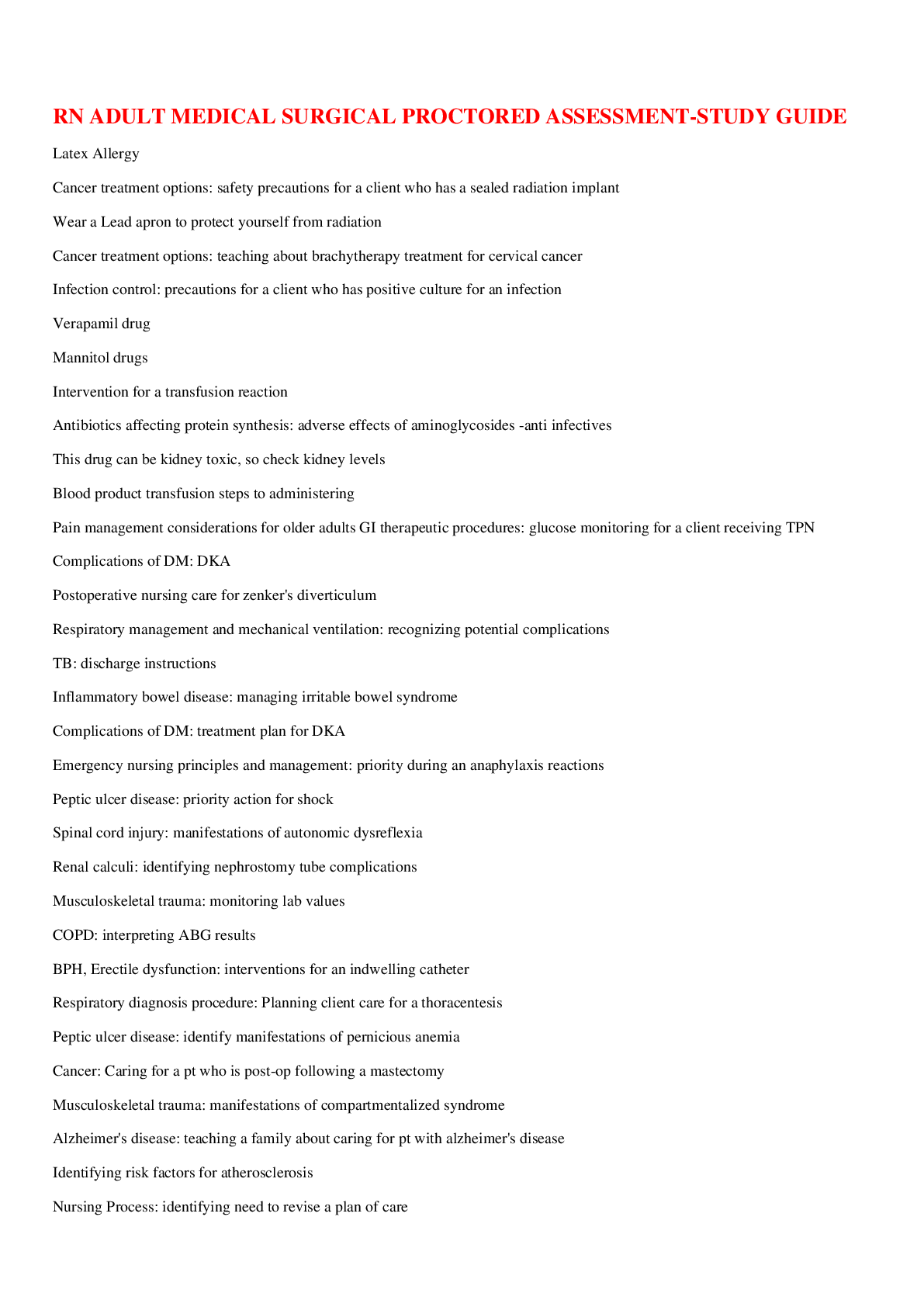
Reviews( 0 )
Document information
Connected school, study & course
About the document
Uploaded On
Sep 24, 2022
Number of pages
21
Written in
Additional information
This document has been written for:
Uploaded
Sep 24, 2022
Downloads
0
Views
36


